President Says He Did Not Request Refurbishment of Summer Villa
ZAGREB, 10 Feb 2022 - President Zoran Milanović said on Thursday he had not requested the refurbishment of a presidential summer residence on the southern island of Hvar, as claimed by Defence Minister Mario Banožić, and would therefore demand a probe.
Following Defence Minister Mario Banožić's statement on Wednesday evening in which he called out Milanović for the refurbishment and investments in the state-owned villa on the island of Hvar, which cost several hundred thousand kuna, the President today denied the allegations that he had demanded the renovation of the building.
The President neither requested the renovation nor had he any knowledge of the refurbishment and investment, performed obviously by the Državne Nekretnine state property management company during Banožić's term as the State Assets Minister, the President's Office said in a press release.
Milanović demanded specifications of the costs of the refurbishment since there could be seen no signs of renovation or investment in the villa that would warrant such an amount.
The President wondered ironically whether during his term as the State Assets Minister, Banožić had got the villa refurbished at his own initiative in order to obtain the President's favour.
Đerek responds to Banožić's accusations
Maja Đerek, a former employee at the Državne Nekretnine company who was accused by Banožić of misappropriating funds for the refurbishment of the villa, counterclaimed on Thursday that it would be useful for Banožić to recall that it was the company's acting director Renata Sabo who was responsible for the management of the Kovač Vila.
Đerek said ironically that Banožić's personal "realtor" Sabo was the person responsible for the case.
Đerek said it was evident from the relevant documents that the refurbishment had been done on 21 May 2020 when Banožić served as the State Assets Minister and when her superior was Sabo.
European Commission Forecast: Croatia's 2021 Growth Second Highest After Ireland
ZAGREB, 10 Feb 2022 - The European Commission on Thursday significantly revised up its forecast for Croatia's economic growth in 2021 to 10.5%, which is the second-highest growth rate in the European Union after Ireland, while downgrading its projections for this year and next compared to its autumn outlook.
The European Commission released its Winter Economic Forecast on Thursday, saying that the Croatian economy achieved a full V-shaped recovery in 2021, surpassing the level registered prior to the 2019 crisis.
After a fall of 8.1% in 2020, the Croatian economy is estimated to have grown by 10.5% in 2021. The only other EU member state with faster growth is Ireland, with a rate of 13.7%.
In its autumn forecast, released in November 2021, the Commission projected Croatia's growth for last year at 8.1%.
As far as inflation is concerned, it is forecast at 2.7% for 2021, 3.5% for 2022 and 1.6% for 2023. These figures are at the level of the euro area average and slightly lower than in the EU overall.
The Commission expects the Croatian economy to grow at a rate of 4.8% this year (compared to 5.6% forecast last autumn) and at 3% next year (the autumn forecast was 3.4%).
After strong growth in the second and third quarters of 2021, growth is expected to have slowed down in the fourth quarter based on short-term indicators of economic activities and price increases.
Exports of commodities and services contributed to the recovery, with tourism playing a key role as well as personal consumption.
Although a strong increase in demand for finished products led to a growth of imports, the contribution of net exports to growth will remain positive.
Investment is also expected to increase, reconstruction should be stepped up after the earthquakes in Zagreb and the Banovina region, as are favourable financial conditions and the implementation of the National Recovery and Resilience Plan (NPOO).
The revised budget indicates that government spending will make a positive contribution to this year's growth.
The risk balance is slightly tilted to the downside, mainly due to problems in implementing projects following the earthquakes. which could negatively affect investments.
This year, inflation could be 3.5% compared to 2.7% last year, mostly due to increased commodity prices. The high inflation rate in the first half of the year is expected to slow down in the rest of the year. Inflation will be most affected by prices of energy and unprocessed food. It is expected to fall below 2% in 2023.
The Commission estimates that after a growth of 5.3% last year, the EU economy will grow at a rate of 4% this year and 2.8% next year. Growth in the euro area is forecast at 4% in 2022 and 2.7% in 2023. The EU as a whole reached pre-pandemic levels in the third quarter of 2021 and all member states are expected to return to pre-pandemic levels before the end of 2022.
Croatian Defence Minister and Israeli Ambassador Praise Military Cooperation
ZAGREB, 10 Feb 2022 - Croatian Defence Minister Mario Banožić and Israeli Ambassador Ilan Mor on Thursday praised the military cooperation between Croatia and Israel, the Defence Ministry said in a press release.
Banožić spoke of technical cooperation in equipping and modernising the Croatian armed forces, participation in courses and conferences, and cooperation in firefighting efforts.
Banožić expressed satisfaction with the defence cooperation and said he was confident that the two countries would intensify their future cooperation to their mutual benefit.
Mor thanked the Ministry for its support in organising the first Lightning of the Heavens memorial march in Croatia, when Israeli paratroopers commemorated Hannah Szenes on the occasion of the 100th anniversary of the birth of the Israeli national heroine.
Szenes participated in World War II as a member of the allied forces. She was arrested by Hungarian gendarmes near the northwestern Croatian town of Čakovec during her attempt to infiltrate Hungary and rescue Jewish people. She was eventually tried and executed by firing squad.
(Hina) vm
‘Superstitious and Debauched’: Impressions of Croatia in Travel Journals of Yore (III)
February 8th, 2022 - In the third and final part of our series, our travellers explore the Kvarner area, discovering bura wind, scampi, and wellness
In our last feature on travel journals documenting trips to the Adriatic, we left off in southern Dalmatia. And now, where our travellers would depart for Montenegro, we’ll circle back to the Northern Adriatic instead. This time, we’re tagging along with A. Fortis (1770s) and G. Marcotti (1890s) - see Part I and Part II for more info and some impressions of Istria and Dalmatia.
Why go back? A good few places were left out of both previous pieces for the sake of brevity, so we’re making this a trilogy to see what our protagonists thought about the Kvarner gulf. It’s a detour alright, but in the words of Fortis who expressed a similar sentiment in one of his letters:
It is a massive geographical leap to move from the island of Brač straight to the island of Rab which is one hundred and twenty miles away. But what can I tell you?
Exactly. But before we get to Rab and other Kvarner islands, let's make a stop in Senj. It’s a coastal town best known for the magnificent Nehaj fortress, a historic stronghold of Uskoks who kept invaders at bay. Fortis says:
A very famous city in the history of the Venetian Republic which had to formally wage a war against it and, being unable to conquer it for a long time, suffered heavy losses in its possessions in Istria and Dalmatia; it was a subject of interest for a Venetian traveller. I wanted to meet the descendants of those fierce Uskoks who were admired for their courage and hated for their cruelty.
I wish I could learn their history as penned by one of them, but Uskoks fought heroically and dealt in ransom and loot collection, and did not write historical accounts.
You don’t say.
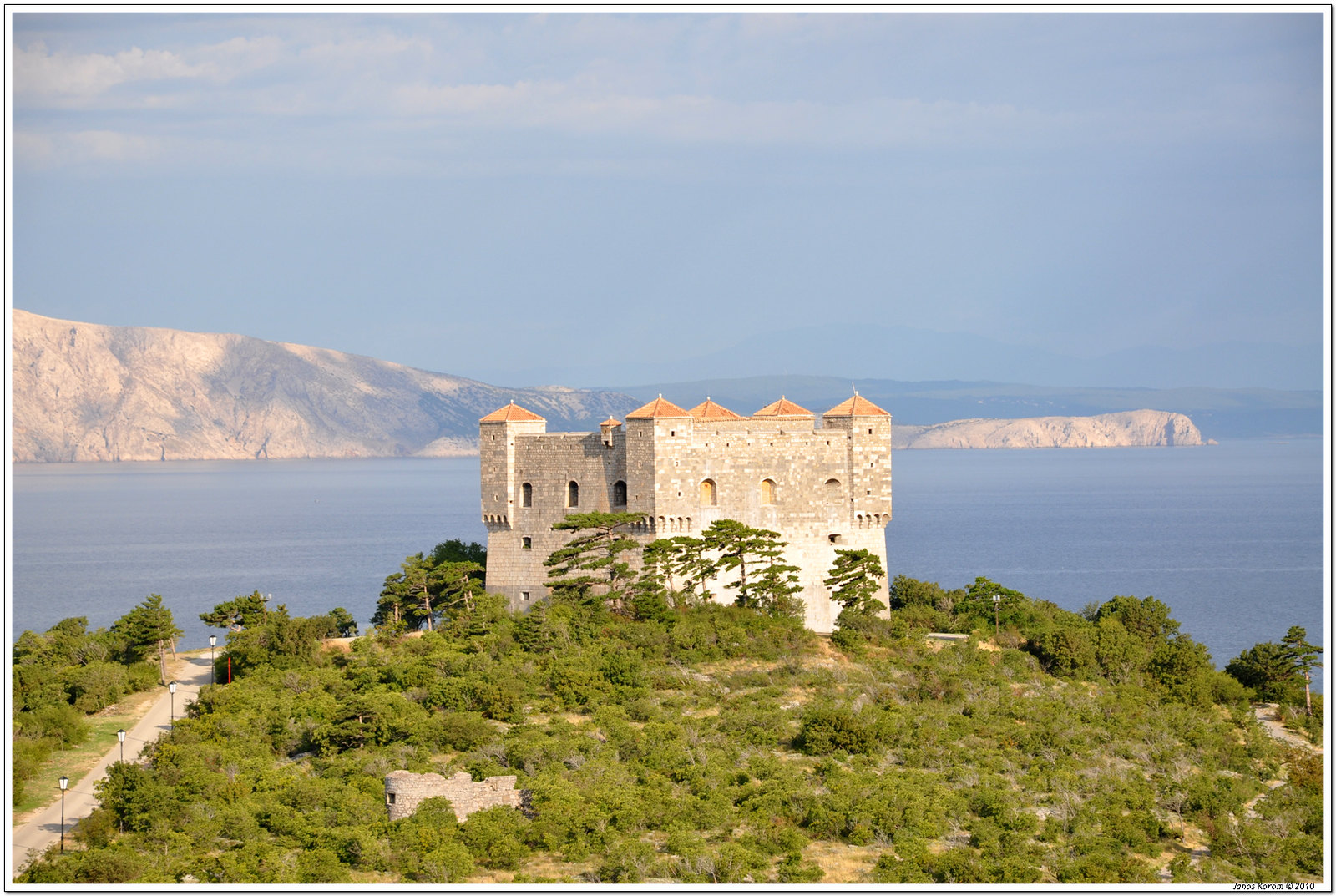 Nehaj fortress / János Korom / Flickr
Nehaj fortress / János Korom / Flickr
With Senj ruled by Austria at the time, the Uskoks truly were a source of headache for Venice; they defended the city, but also plundered Venetian galleys along with most other commercial ships in the area. Their conquests had a blessing of the local clergy, monasteries received a tithe from the bounty, and so the 16th-century Senj essentially thrived on piracy and looting. It's not a surprise then that its population might've seemed a bit, uh, laid-back to an outsider:
The people of Senj are superstitious and debauched at the same time. The women of this city are said to be prone to love affairs; they are easy-going and in this regard do not bear a resemblance to Croatian women.
Uh-oh. Shall we proceed with caution? Luckily, instead of lamenting loose morals, Fortis turns this into social commentary:
And so romantic adventures are frequent, and sometimes followed by unpleasant consequences. The bishop and the monastery heads who make up the court that deals with these matters issued a decree a few years ago, stipulating that if an unmarried woman were to give birth to a child, she could not sue her lover in court for marriage or possessions. This cruel ordinance led to an even greater decline of morals, and every year, many unfortunate girls are sacrificed to disgrace for which there is no cure; it is heartless and outrageous barbarism.
A progressive stance for the 1770s.
To finish, a few of his thoughts on the infamous Senj bura:
The wind coming from the barren mountains blows so fiercely in that narrow gap, there are times in winter when one cannot leave the house without peril, and it is even worse outside the city. Even when they do not walk across the square where no sensible person would appear at such times, but through the narrow winding alleys, it often happens that children and frail folk are lifted from the ground and slammed against the wall by the wind. When an urgent need compels someone to go to the docks where ships are anchored, despite crawling on their hands and knees they sometimes roll away like a straw because of the force of the wind.
Senj bura hasn’t lost any of its force to this day, and Fortis was wise not to take it lightly.
***
Now, to Rab. Those who read the first part of this series might recall his unabashed trashing of the poor populace of Pag island, and it would appear that Fortis really held a grudge against island folk in general:
The island of Rab would have everything needed to support its small population, if only its agriculture was in the hands of less stupid and lazy people.
He continues:
Nevertheless, [the island] produces firewood, shipped off to Venice on the backs of numerous donkeys each year, as well as grain, oil, excellent wine, brandy, and since the ancient times - silk, the silkworms feeding on black mulberry leaves. Exported are also leather, wool, sheep, pigs and horses of good breed.
I don’t know, they don’t sound that lazy to me. There’s more:
The sea is beginning to be of use, with salt pans maintained on the island that give an abundance of good fine salt. In addition, in spite of fishing being carried out here in a very poor and sloppy manner, the catch of tuna, mackerel and sardines is an important item in the trade of the people of Rab who (as the rest of Dalmatia) prefer to sell their goods to foreigners rather than Venetians. Despite all these natural products, the island is far from being rich or achieving adequate progress, as uncultivated land and idle peasants are too commonly seen.
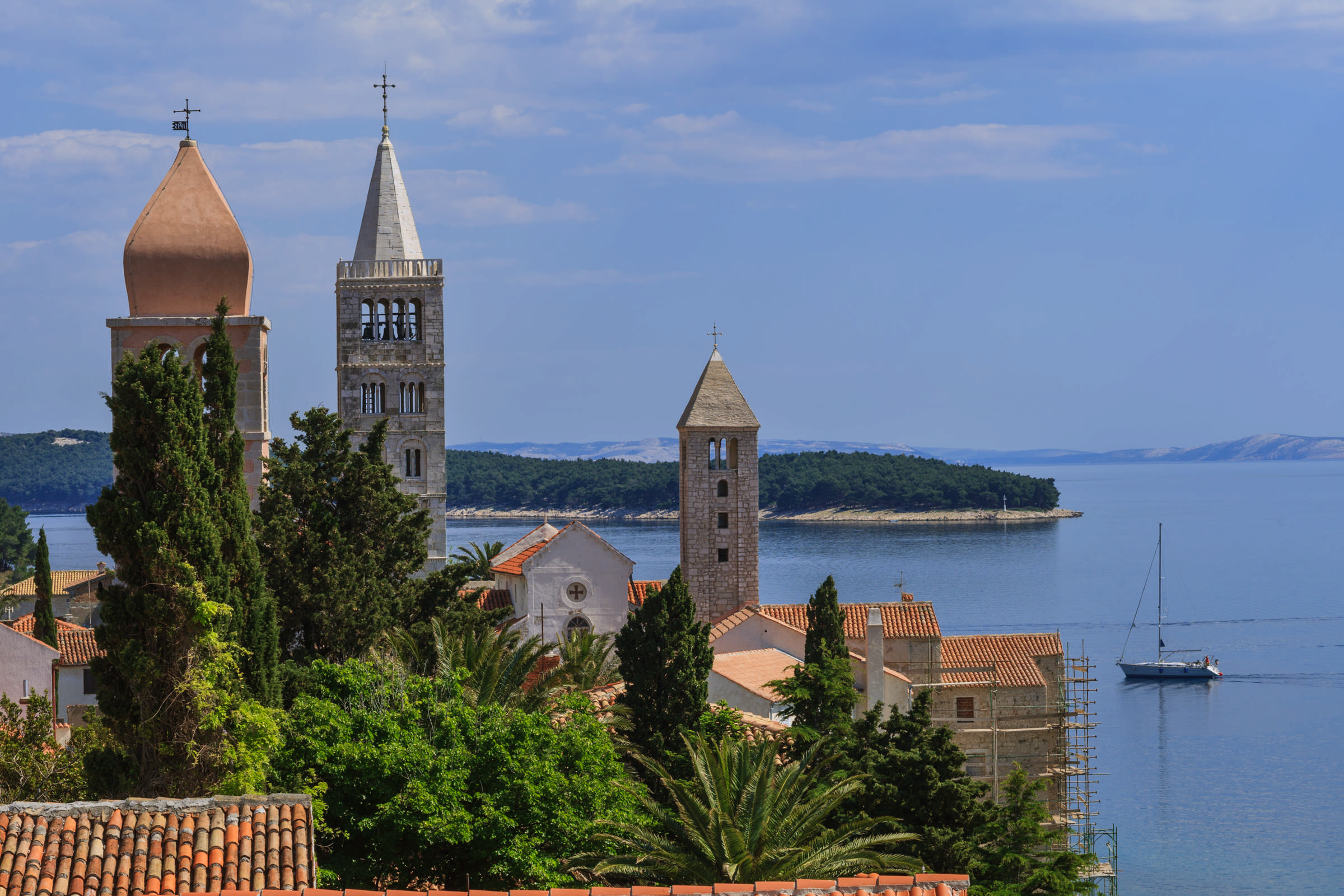 Rab town by Romulic and Stojcic
Rab town by Romulic and Stojcic
And an anecdote:
In the past, there was a bishop of Rab named Ottavio Spaderi; it occurred to him not to allow on the feast of St. Christopher for his relics to be displayed for public veneration, seeing as he doubted their authenticity. The folk rebelled, wanting to throw him into the sea from the top of the hill on which the cathedral stands, and the riots did not subside even after the moment had passed. The government had to send a warship to save the prelate from peril, and the pope considered it his duty to grant him a more submissive congregation in Italy.
Feisty. Fortis is lucky he wasn’t thrown from a cliff as well.
***
Later on, Marcotti writes about what you can find on Lošinj island:
A hunters’ association, a branch of the tourist club, a company for afforestation and landscaping. (...) There is no shortage of foreigners: Mali Lošinj has the Vindobona hotel, three special trattorias, five boarding houses. There are two other guesthouses and a resort for convalescent children in Veli Lošinj.
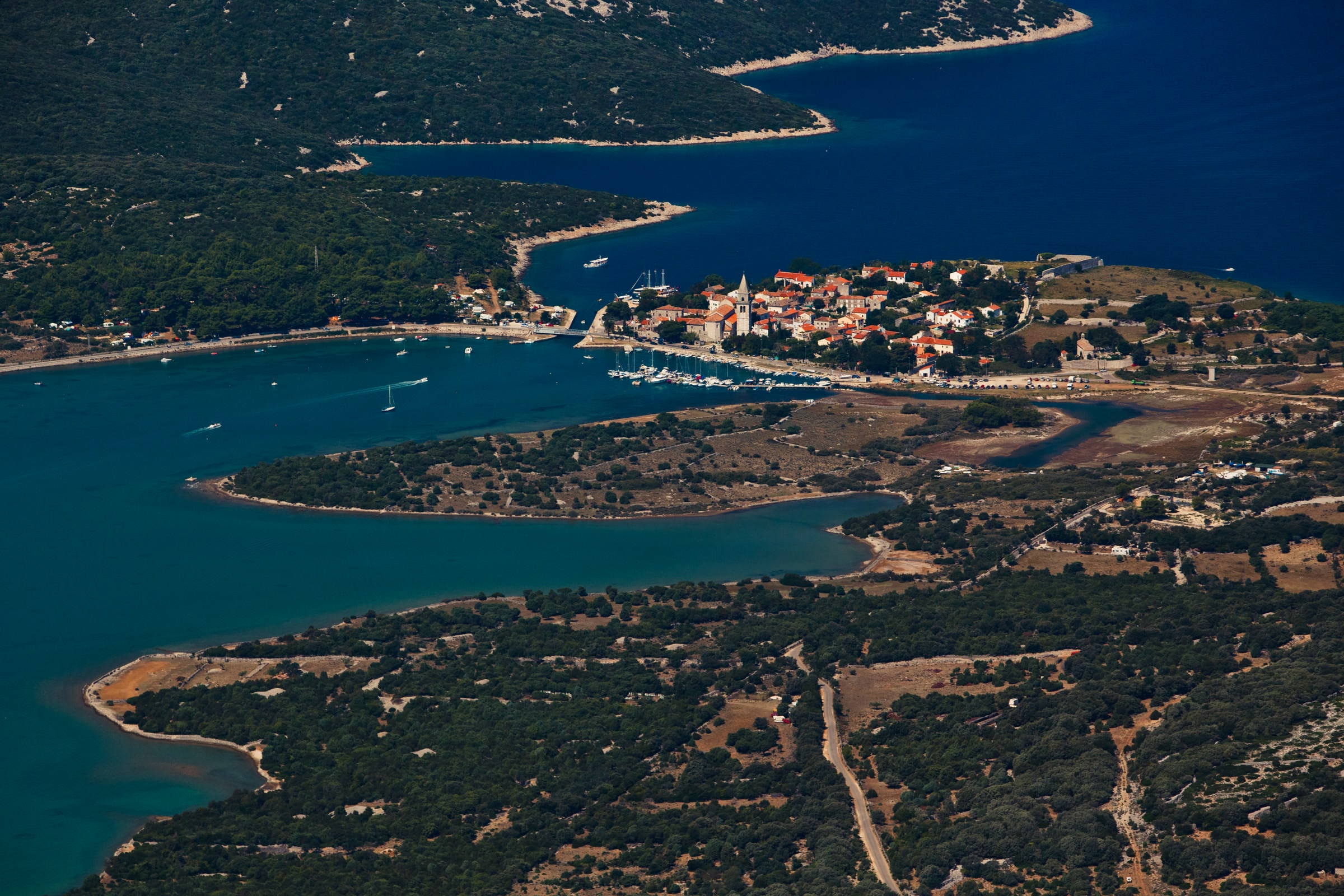 Osor town on Cres island by Romulic and Stojcic
Osor town on Cres island by Romulic and Stojcic
Visiting Cres island, he notes:
Generally speaking, sheep herding is difficult on islands of Kvarner due to bura; large juniper trees, grown and naturally shaped into canopies by the frequent pressure of the wind, provide shelter to roaming flocks.
***
On to Rijeka, the biggest town in the Kvarner gulf, visited by both our travellers. Fortis first:
Croatian is the native language. Refined folk of both sexes speak good Italian, imitating the Tuscan manner of speaking; surely they should be praised much more than us who butcher our beautiful language but mock everyone else who endeavours to speak it unless they are born in Tuscany.
The people of Rijeka are mild-mannered, and their company jovial, though marked by moderation.
Marcotti also spends some time in Rijeka and doesn’t let us down. Two of the most important things in any destination: where to eat and how to get around!
Numerous trattorias as well as those operating as part of hotels; breweries of the leading Austrian factories. Scampi are delicious, especially served in risotto. [There are] car services, omnibuses, public valets.
…that last one being a somewhat loose translation, referring to a particular profession: a person stationed in a public place ready to help you with any given need or errand. Think a concierge, a tourist guide, a messenger, a personal shopper, a delivery service, all rolled into one. Looking for directions to a certain place or perhaps need a hand with those shopping bags? The public valet’s got your back.
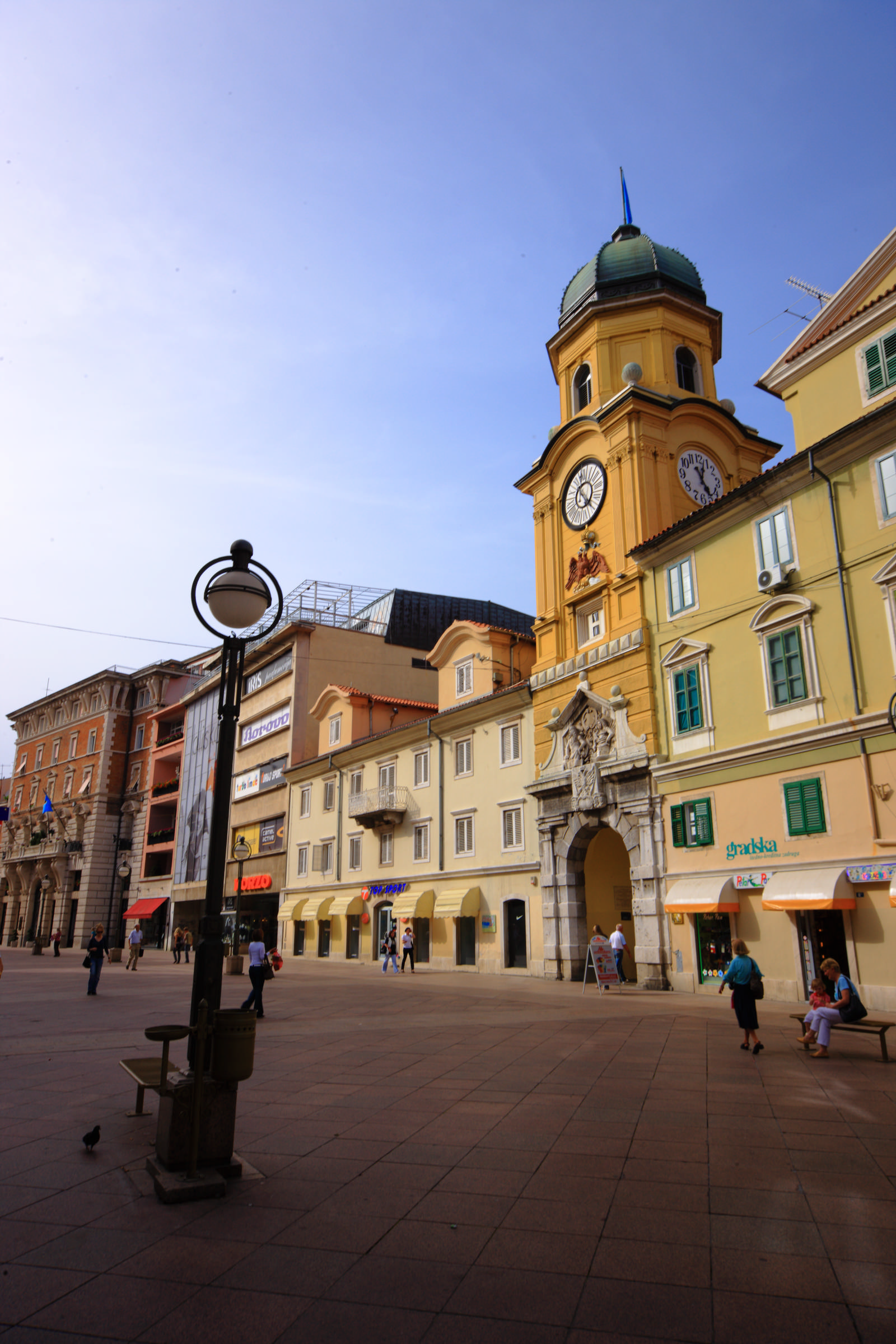 Rijeka by Romulic and Stojcic
Rijeka by Romulic and Stojcic
He goes on:
The look of the city is really nice, its architecture Italian in character, though it offers little of note when it comes to art.
Ah well, you win some, you lose some. At least there are good scampi.
And for a final thought, a line used time and time again, a variation of which is probably currently displayed somewhere on the pages of the local tourist board:
The panoramic view of Rijeka and the Kvarner gulf as seen from Trsat is truly magnificent.
***
Opatija has grown into a fully fledged tourist destination by this point (late 1890s), and a health resort at that. Marcotti reports:
There’s a good number of nonagenarians in perfect health living on this riviera.
Its most sheltered and most pleasant place, Opatija, is advertised by the Südbahn company (Southern Austrian railways) as a health resort for the winter and sea-bathing in the summer. It has developed formidably and can barely accommodate the large clientele that flocks to it, particularly those from Austria-Hungary and Germany.
The entire facility cost the Südbahn no less than 3 million florins. There are milk, honey and egg treatments, massage, gymnastics, and walks for health.
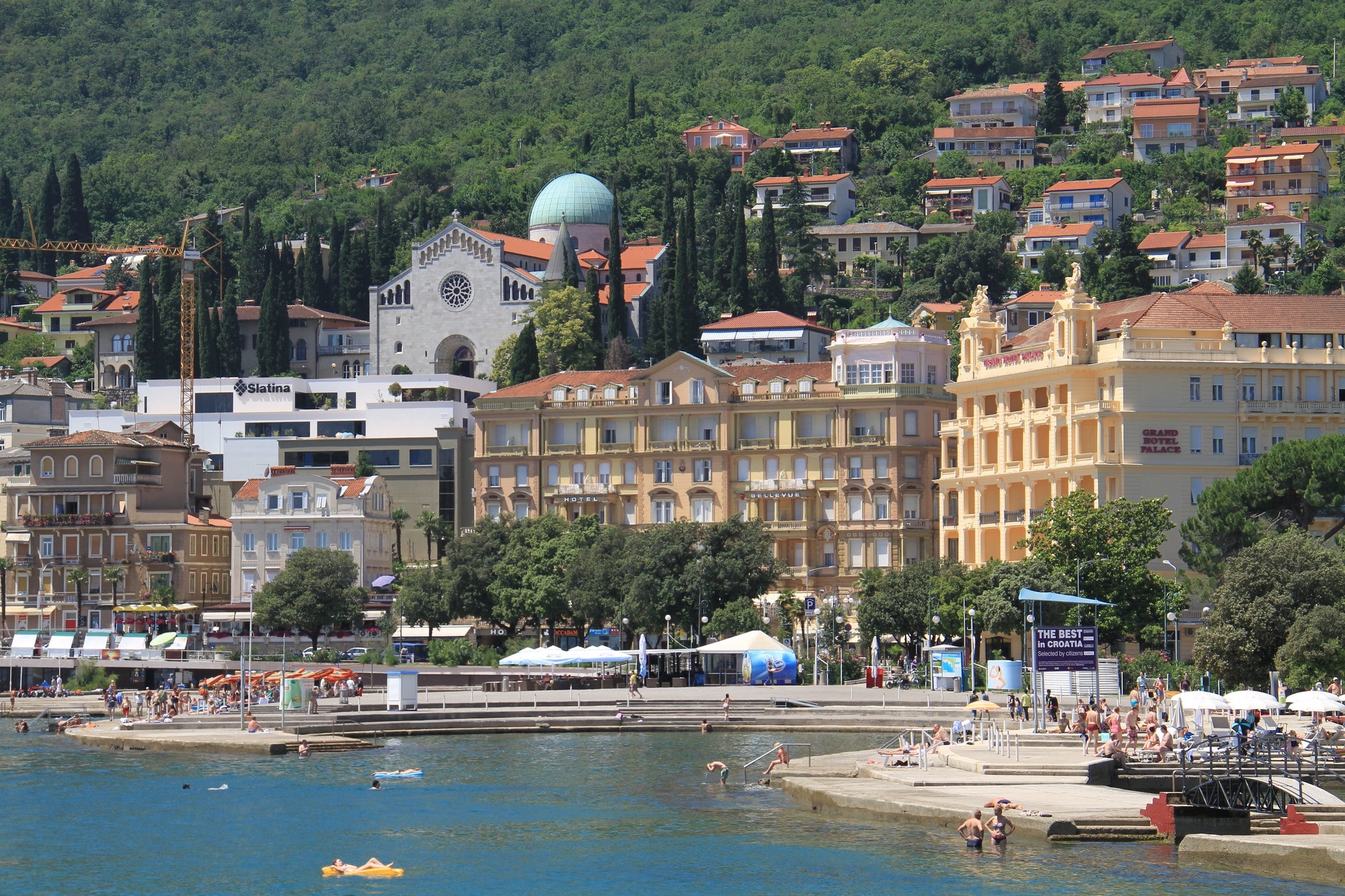 Opatija by Ronnie Macdonald / Flickr
Opatija by Ronnie Macdonald / Flickr
Some interesting insight into the early days of wellness, followed by a short recap showing just how quickly Opatija gained a reputation as a place to be:
Starting from 1885 (when Archduke Rudolf and his wife Stéfanie stayed here for the first time) visiting and staying in Opatija has become a pastime of high regard, very fashionable in court circles and among aristocrats and diplomats. This is from the 15th of October to the 15th of May: in the other five months, the bourgeois society visits for sea bathing. Empress of Austria, many archdukes and archduchesses, the royals of Serbia and Romania were some of Opatija’s guests.
***
With tourism becoming an industry, this seems like a good place to end this feature. Admittedly, when it comes to travel journals that paint a picture of the Croatian coast in earlier times, we’ve barely scratched the surface in our three-part series. Countless travellers have chronicled their Adriatic adventures, and providing you have time and the resolve to peruse old texts, it’s a fascinating body of work to study. We kept the scope small not to turn this into a dissertation, but hope you’ve enjoyed our travellers’ reviews anyway. Just keep in mind these are opinions of individuals from centuries past, and not neccessarily an actual representation of what Croatia is like - lazy folk, loose morals and local superstitions included.
Sources for Part III:
Giuseppe Marcotti, L’Adriatico Orientale, da Venezia a Corfu (1899)
Alberto Fortis, Viaggio a Dalmazia, 1774 (Croatian edition: Put po Dalmaciji, Globus, Zagreb, 1984)
‘Besides, the Food Is Very Good’: Impressions of Croatia in Travel Journals of Yore (II)
February 5, 2022 - In the second part of the feature exploring impressions of Croatia found in old travel journals, we're retracing the steps of several foreign visitors in Dalmatia.
If you haven't read the first part, please head here to meet our protagonists, fearless adventurers and diligent reviewers, and see what they thought of Istria. We’re picking up where we left off, with all of our esteemed travellers heading further south.
First up, Zadar, the main Venetian base on the Croatian coast back in the day and thus an obligatory stop on every tour of the Adriatic. Very well defined in this succinct statement by archaeologist Jacob Spon who travelled in Dalmatia in 1675:
It’s the capital and one of the best places that the Republic owns in Dalmatia.
He also liked the cathedral and excellent paintings of Titian and Palma displayed in the churches of Zadar, but I’ll spare you the rest of the paragraph as it’s not more than a list of artworks.
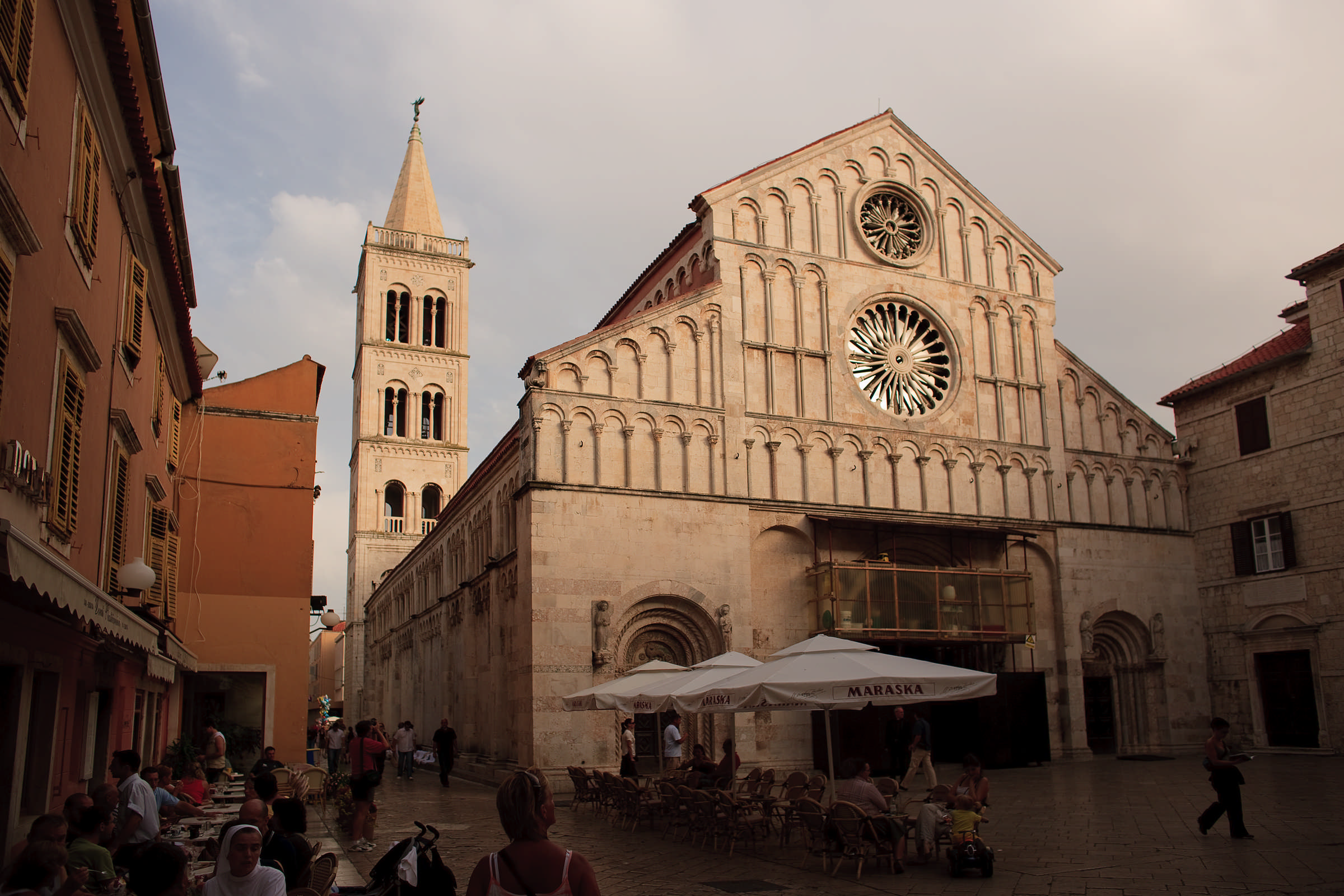 Zadar cathedral by Romulic
Zadar cathedral by Romulic
A few thoughts on Zadar by Noé Bianchi who visited in the 1770s, in his trademark enumeration style:
The city has six gates, a great Arsenal, and many ships and boats. It is a beautiful port, and a place to live in abundance; its territory spans over thirty miles on the mainland, with many castles, islands, and more than four hundred reefs. There are large pastures with plenty of livestock, and an abundance of all sorts of fish; they dress pompously, are very devoted to arms, but above all to humanist studies; they have many schoolmasters, and a lot of merchants.
Let’s hope it was the people of Zadar who dressed pompously and not the fish. Thankfully, we have a new character in our story: countess de La Morinière de La Rochecantin who offers her view of the locals, having visited Zadar in 1907:
The men are not handsome at all; their eyes are hard, their facial features sharp. The women, on the other hand, have a beautiful smile and something seductive under those colourful scarves with which they cover their heads.
Sorry, men of Zadar.
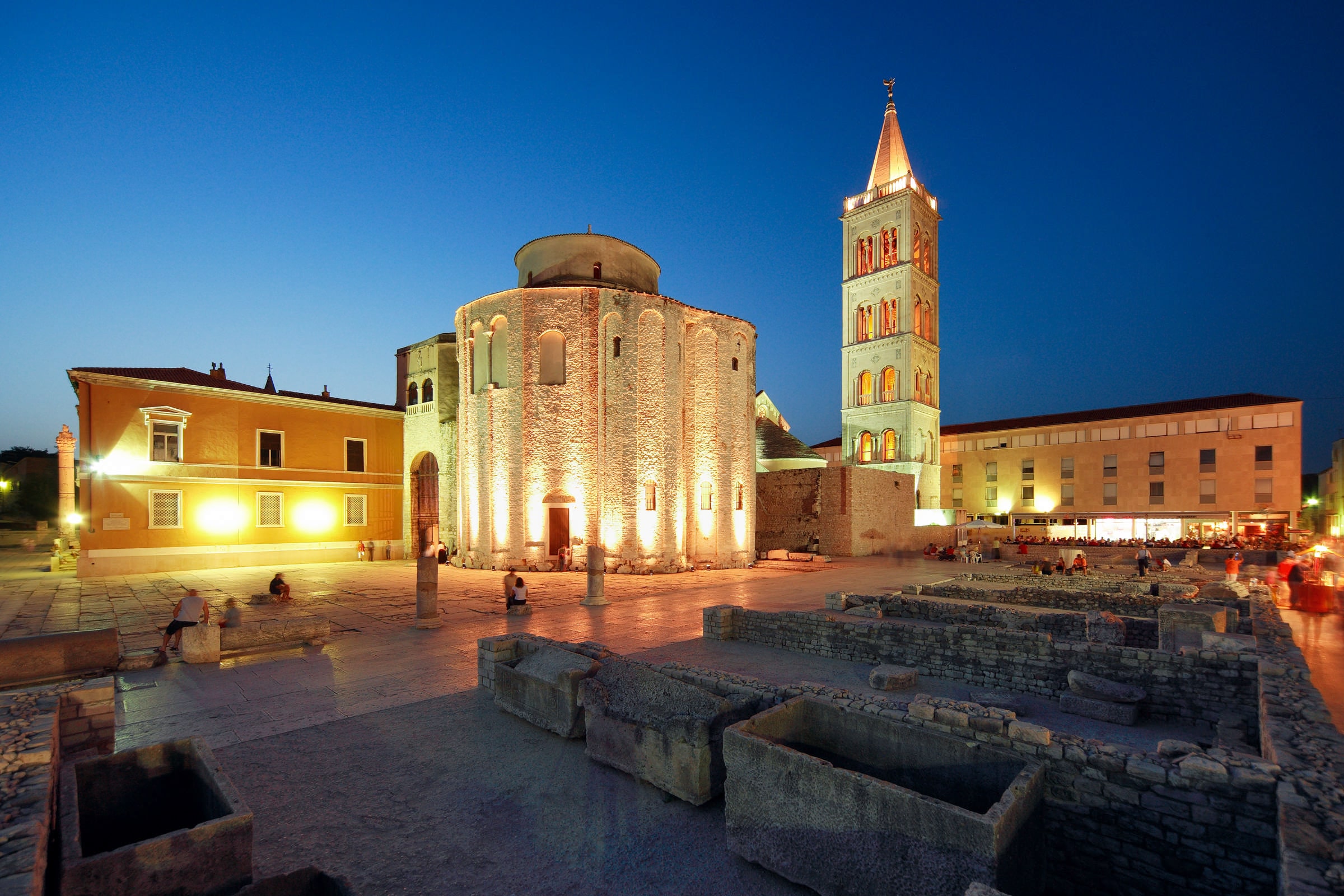 Zadar by Romulic
Zadar by Romulic
***
On we go to Trogir, where the countess notes the following:
The inhabitants are largely similar to those of the Illyrian islands, but this lot is more gentle. They live here in a small Provence. Tamarisk trees and pines, through which a soft wind whistles as if in song, line the narrow paths that run along the shore.
This morning, the water glistens with opal reflections, the air is gentle and warm, but it’s enough for the sky to get veiled in clouds for a feeling of melancholy to take hold of us. In these countries where the sun is king, it alone gives life to beings and things: aromatic plants, trees with pale foliage; the flora of such ardent regions only comes alive and reveals all its splendour and perfumes in the light and under the scorch of the sparkling star.
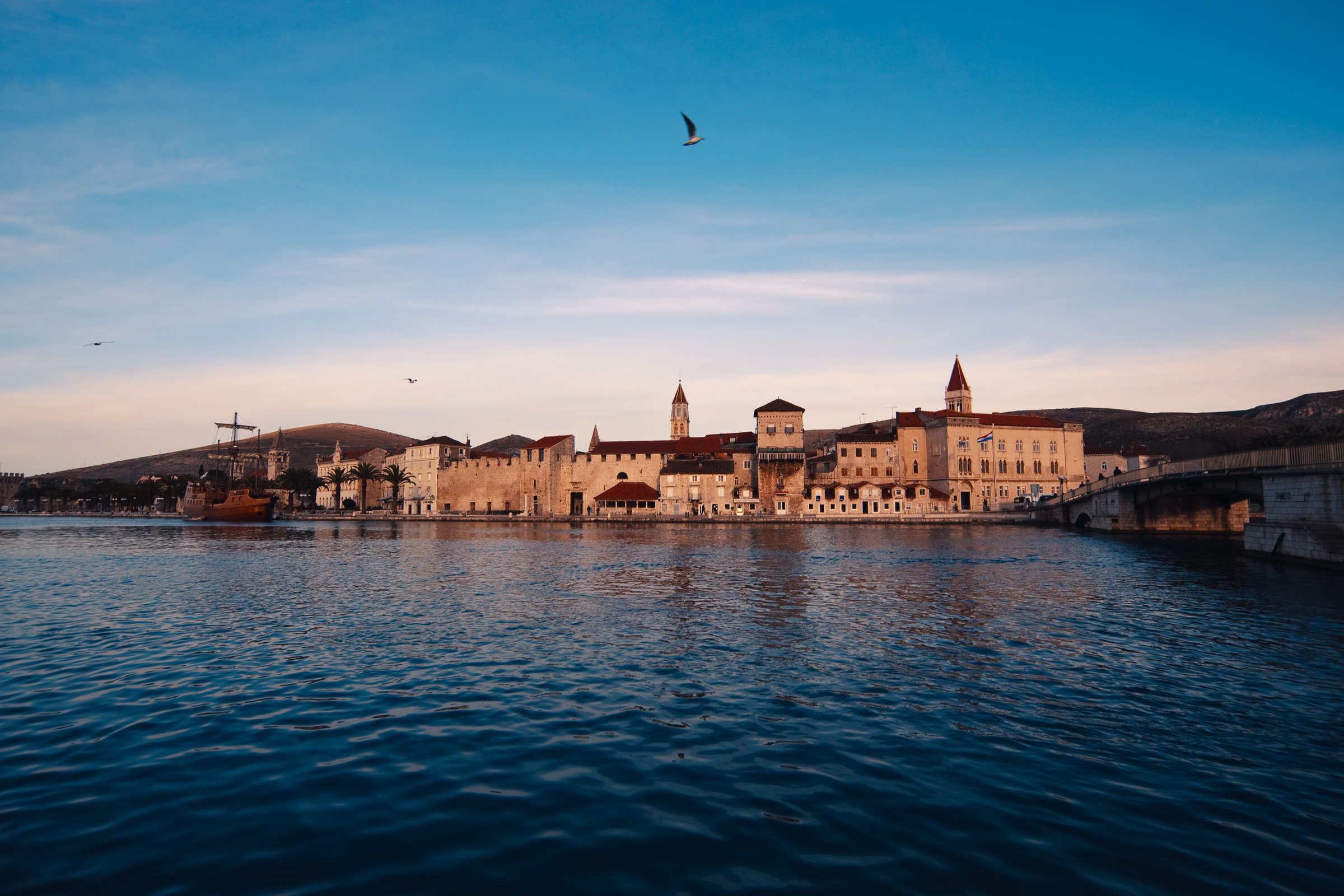 Trogir by Mario Romulic
Trogir by Mario Romulic
Spon on the other hand has a less poetic approach and seems to be excited about Trogir mostly due to it being the birthplace of Ivan Lučić Lucius, a Croatian historian of international renown.
Lucius is known as the father of Croatian historiography owing to his work 'On the Kingdom of Dalmatia and Croatia', in which he gives a comprehensive account of Dalmatia’s history from the Roman times to the end of the 15th century. Seemingly enough to merit admiration from monsieur Spon who, as we’ve learned, wasn’t easily impressed:
This monsieur Lucius is a nobleman from this country whom I had the honour to meet in Rome, where he is now residing. His homeland is indebted to him for having pulled it from the shadows of antiquity with the historic account he made.
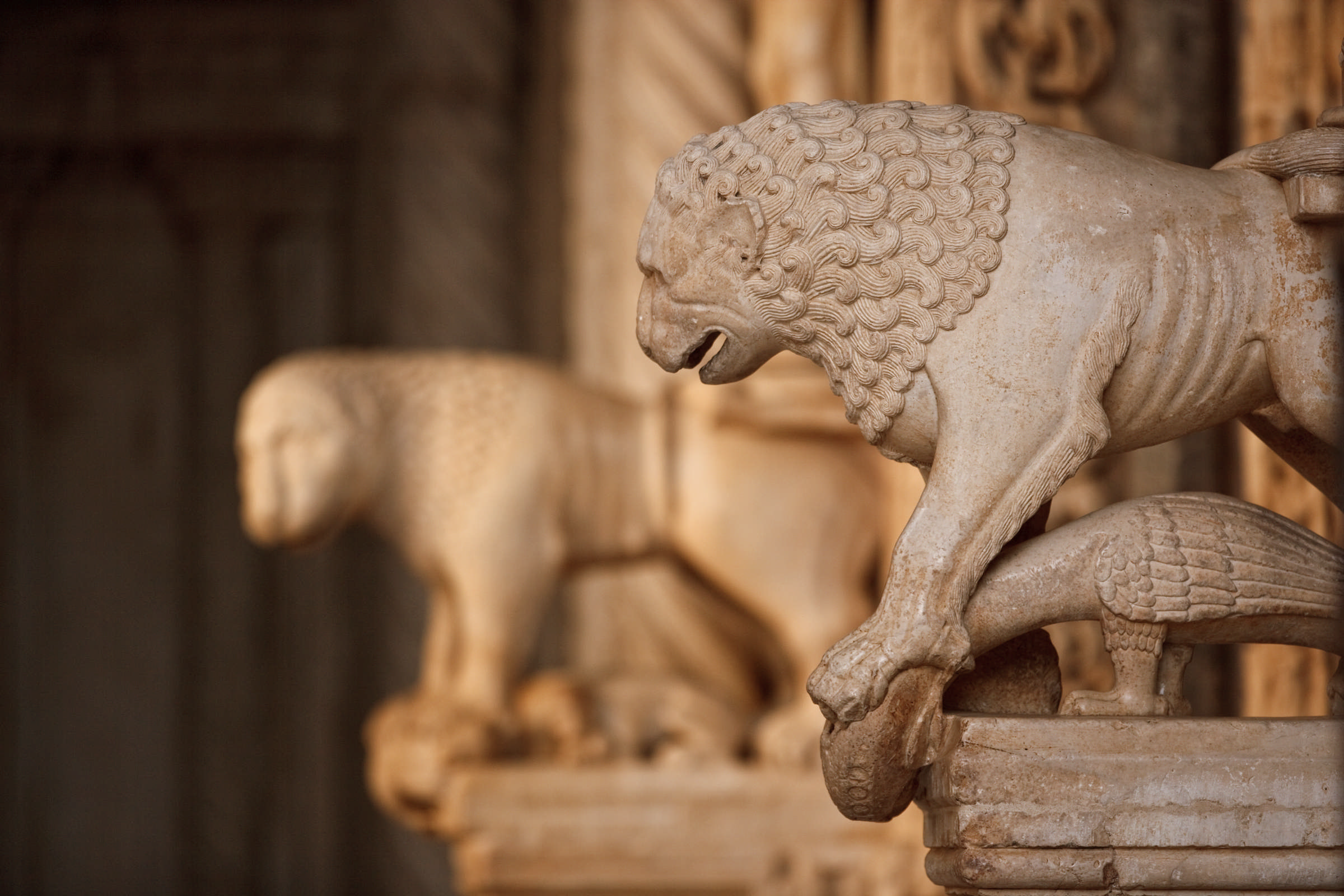 Trogir by Mario Romulic
Trogir by Mario Romulic
Immediately upon arrival, Spon and his party are struck by one of the worst troubles that can happen on a trip: no place to stay!
We had arrived in Trogir at dinner time and were looking for lodging, when we were told that we had to make our own arrangements for dinner, and that it wasn’t customary in that land to deal in hospitality [accommodation].
Naturally, as they were starving at that point, they weren’t exactly happy to hear this, but they got lucky shortly thereafter and found a place in town that sold wine. They were soon ushered into a nearby building that turned out to be none other than Lucius’s palace. This one:
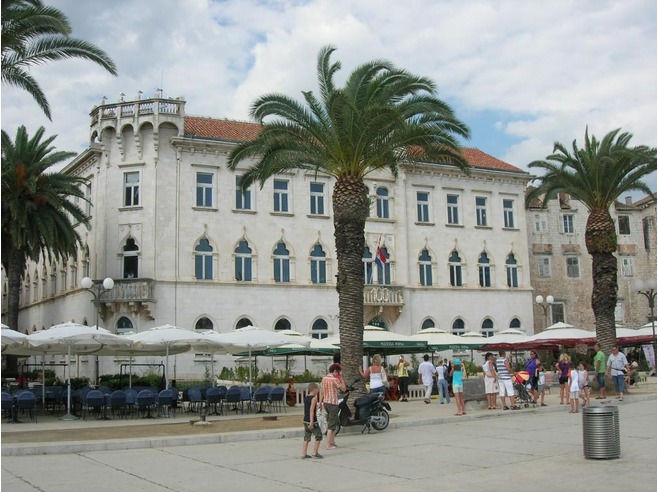
We were surprised to see this house, which is quite beautiful and has a view of the sea, empty and as if deserted, and we were even more surprised when we were told it was the house of this monsieur Lucius whom I just talked about. It has been more than twenty five years since he left it, all because of the incivility of a General of Dalmatia who, having arrived in Trogir, let [Lucius] know he wanted to lodge in his house. The nobleman was getting ready to receive him, and left for himself only a mediocre apartment. But the general immediately sent his people to take all the furniture outside. This impudence annoyed [Lucius] so much, he left the country immediately and never wanted to return.
Loving the gossip. Any thoughts on the sights, though?
The cathedral isn’t ugly. There are some statues in the church, made by a fairly good hand.
Today, the historic centre of Trogir, including the cathedral of St Lawrence, is a UNESCO World Heritage Site.
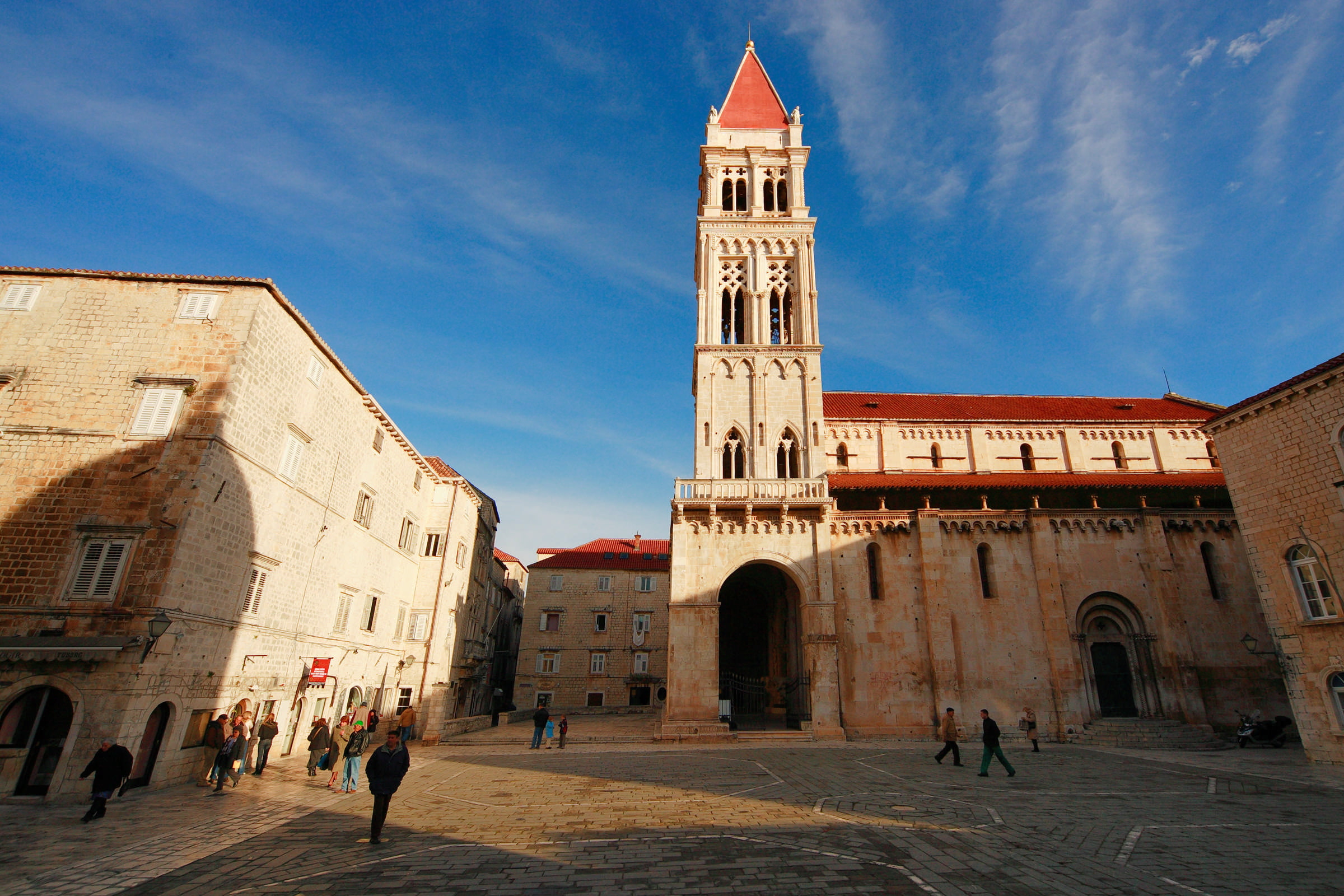 Trogir by Mario Romulic
Trogir by Mario Romulic
We have another appearance by Alberto Fortis who shares a warning: don’t get scammed on your travels! After two pages of musings on marble and its various properties, he says:
As I searched in vain around Trogir to find the famed marble, someone showed up who wanted to abuse my lack of guile by presenting me with a piece of Carrara marble as if it were taken from the nearby hill of St Elijah, where you can find old quarries whose marble isn’t rough at all, but is still far from the refined marble of Carrara.
No one's taking Fortis for a fool!
A traveller must always keep their guard up, as I have, before they draw conclusions based on other people’s claims. I.e., they should go directly to the site in question or at least threaten to do so in spite of all difficulties; that is how you uncover lies.
A marble-related crisis isn’t a situation a lot of us are likely to find ourselves in these days, but fine advice nonetheless.
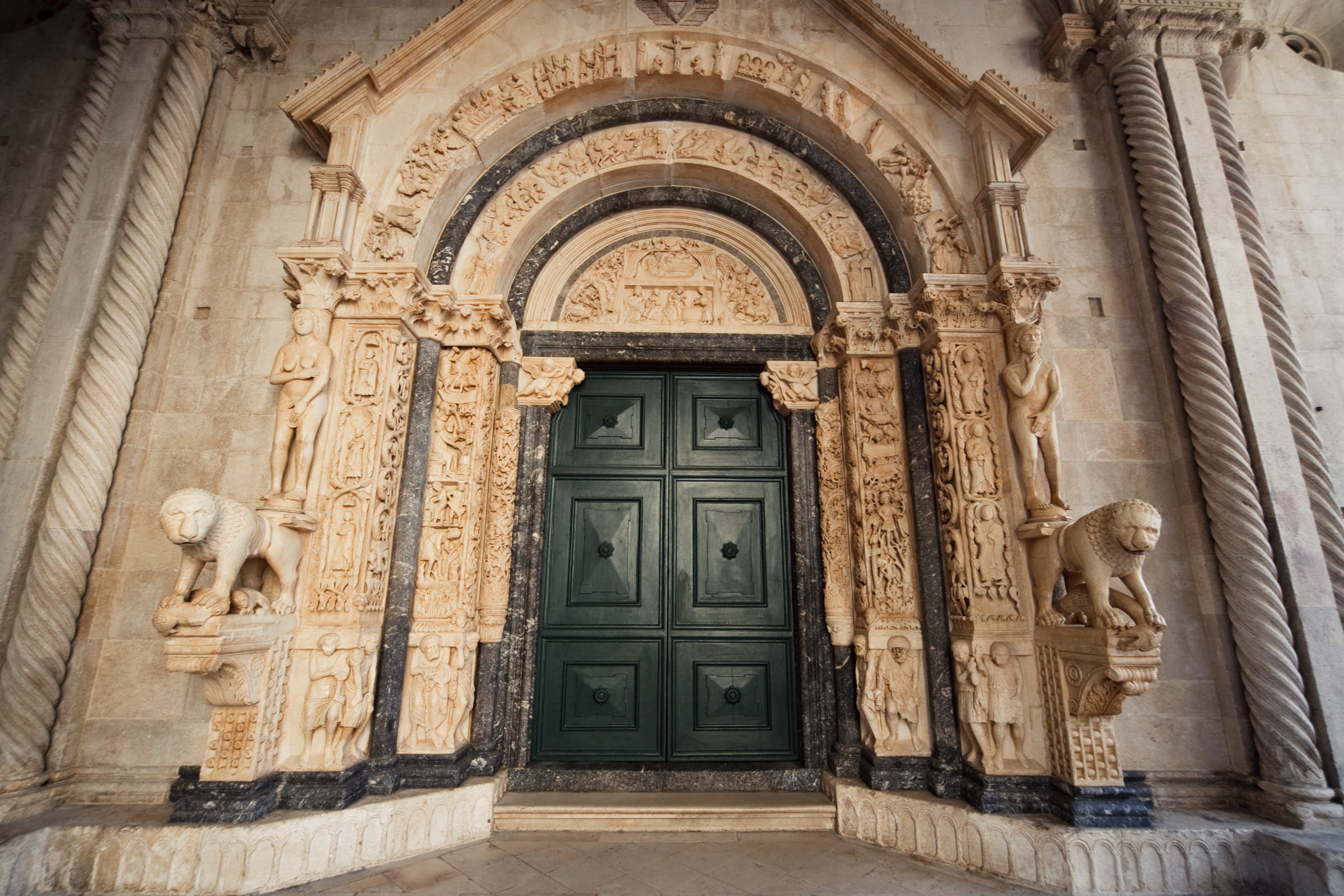 The portal of Trogir cathedral by Mario Romulic
The portal of Trogir cathedral by Mario Romulic
He adds a few favourable impressions of Čiovo island:
The island’s climate is truly very pleasant, the air perfect, oil, grapes and fruit excellent, the sea rich in fish, the port spacious and shielded. And its surface isn’t so small that a nobleman couldn’t comfortably walk or ride around it.
Good to know.
***
Before we go on to Split, a note on the hinterland by Marcotti, an Italian writer visiting in the late 1890s:
Those who want to be more in control of their time while travelling in the Dalmatian hinterland will prefer to travel by horse, but will have to get accustomed to a common lack of comfort in regards to accommodation and food: pecorino cheese, stale bread; plum brandy to drink. Corn polenta, ham, roasted lamb, smoked mutton and wine are items of luxury.
***
I believe we’re all familiar enough with the splendour of the Diocletian’s palace in Split to skip the lengthy elegies about its magnificence. Instead, let’s see a few impressions of the town in general, starting with Marcotti:
The market is especially crowded on Monday and Thursday mornings. It is interesting to see how peasants and people from the outskirts of town are dressed: bright colours (blue, red and black), large pieces of jewellery, filigree, gold and silver buttons, chains, medals. Compared with the Morlach women, the women of Kaštela stand out with their elegance.
The countess gets philosophical:
A rosy and curly child, with a serious expression of a grown man, leads us through narrow streets in the ruins of the palace. There is something moving about this loyalty that leads men to live where their ancestors lived, be it within the crumbling walls of an ancient palace or next to a dormant crater that will sooner or later sow devastation and death around it.
![]()
And Spon was surprisingly won over by Split, having spent ten days not doing much other than sampling the local cuisine:
The time we spent in Split did not last us long, because we discovered something new every day and besides, the food was very good. The only downside was accommodation which was not very convenient, as we found but four bare walls.
Partridge only costs five sols there, and hare doesn’t cost much more. There is meat at the butcher’s for one sol a pound, and turtles the size of two fists for four or five sols. But more often than not we preferred to abstain from meat and eat those little trouts from Salona, of which Emperor Diocletian was so fond, that for fear of running out of them he had an express conduit made which brought them to his palace.
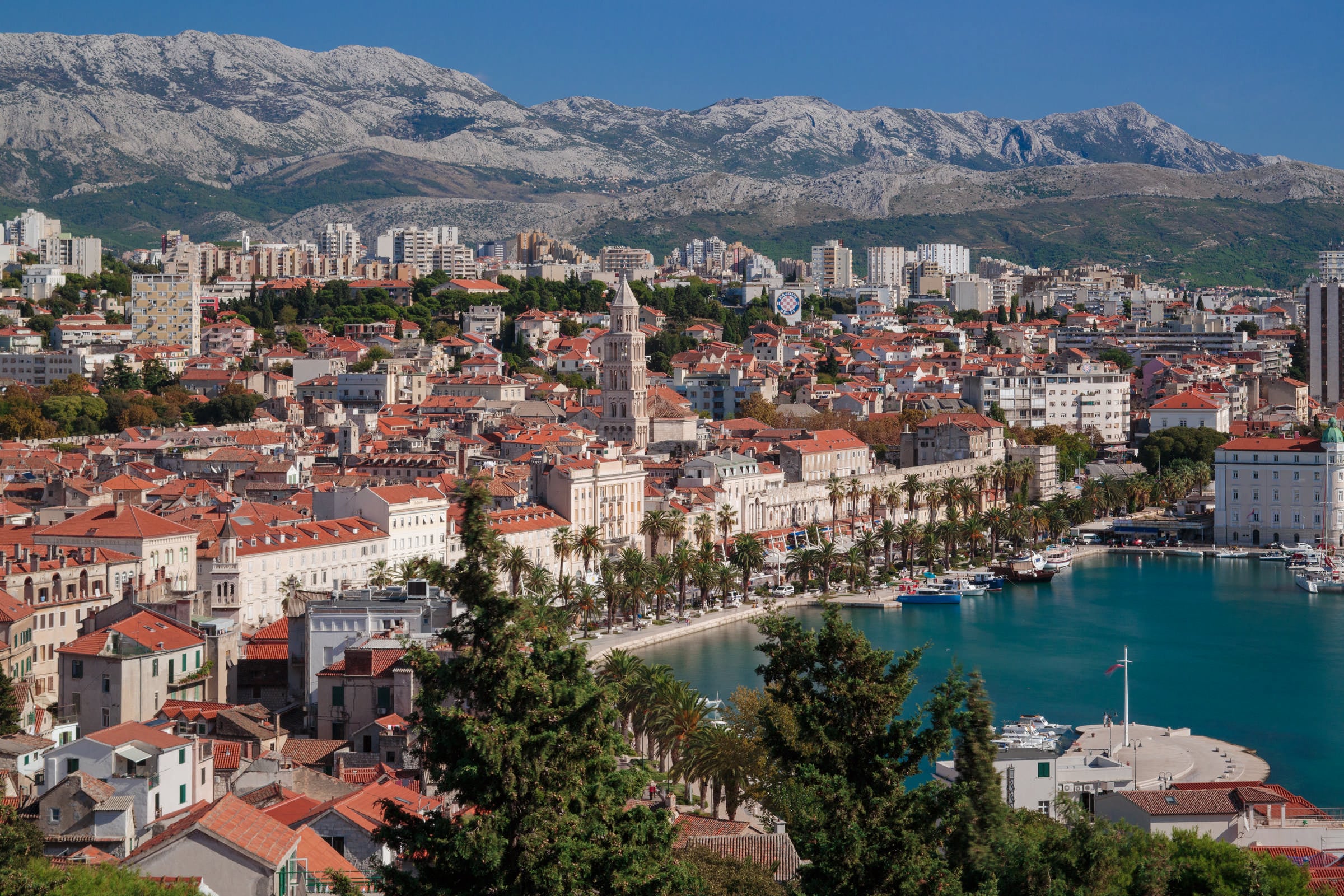 Split by Mario Romulic
Split by Mario Romulic
All of our brave travellers then went to see Klis. Marcotti offers some practical information:
From Split via Klis (2 hours) to Sinj (5 hours), superb road, but the postal service only operates twice a week. A permit from the commander’s office in Split is needed to visit the Klis fortress; it is not granted to ladies.
Rude.
It would take long to recall the whole of its glorious military history, he says about the fortress, then recalls it anyway. A history lesson later, he goes on to say:
The road, the gates, the barracks, they’re all modern; but the walls, the towers, the ramparts, all retain the picturesque charm of ancient military gear: the mosque was transformed into a warehouse. And there’s a beautiful view to boot. In the village, nestled on terraces below the fort, are several taverns.
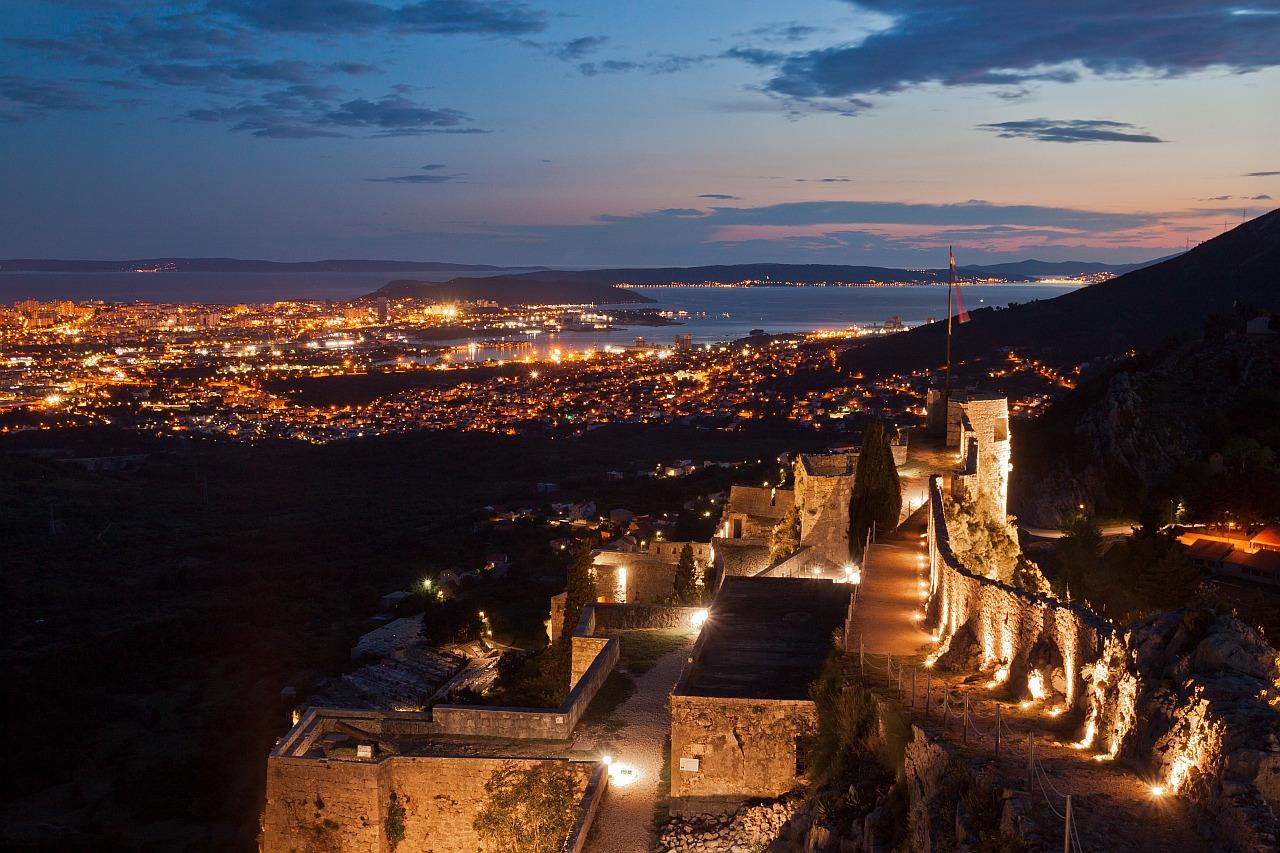 Kliss fortress
Kliss fortress
Countess Rochecantin:
The citadel of Klis, truly an eagle's nest which proudly dominates the valley. The rock it’s built on is surrounded by peaks which would seem inaccessible, if it wasn’t for little pockets of greenery bearing witness to the patient conquest of man over this rugged nature.
And then there’s Spon, bless his heart:
There’s a lack of water and it gets terribly cold in winter. I imagine it’s a harsh penance for a Venetian nobleman to serve here as an officer for two years. 2/10
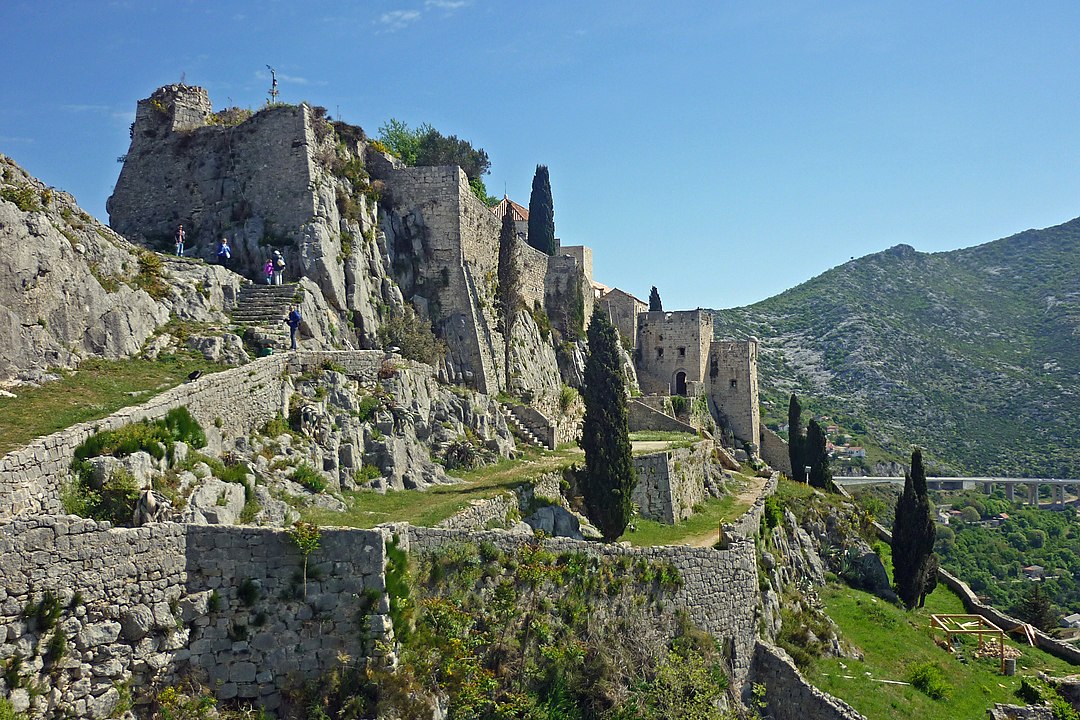 Kliss fortress
Kliss fortress
Marcotti offers a few pointers for towns and islands in the area:
At the mouth of the river Cetina, between Mount Biokovo and the sea is Omiš, a formidable ancient pirate nest. Ruins of the Mirabela and one other castle: excellent wines, pink muscat, even some dessert sparkling wines.
The man truly tells us what we want to know the most.
Šolta isn’t big: its chief town Grohote only has 1200 inhabitants. It’s been renowned for its honey since ancient times; the bees only suckle on rosemary.
Brač is the most important Dalmatian island, in terms of size, population and wealth. They produce vugava, an excellent prošek wine. (...) In the village Pučišće are quarries where stone was sourced for Diocletian’s grand construction in Split.
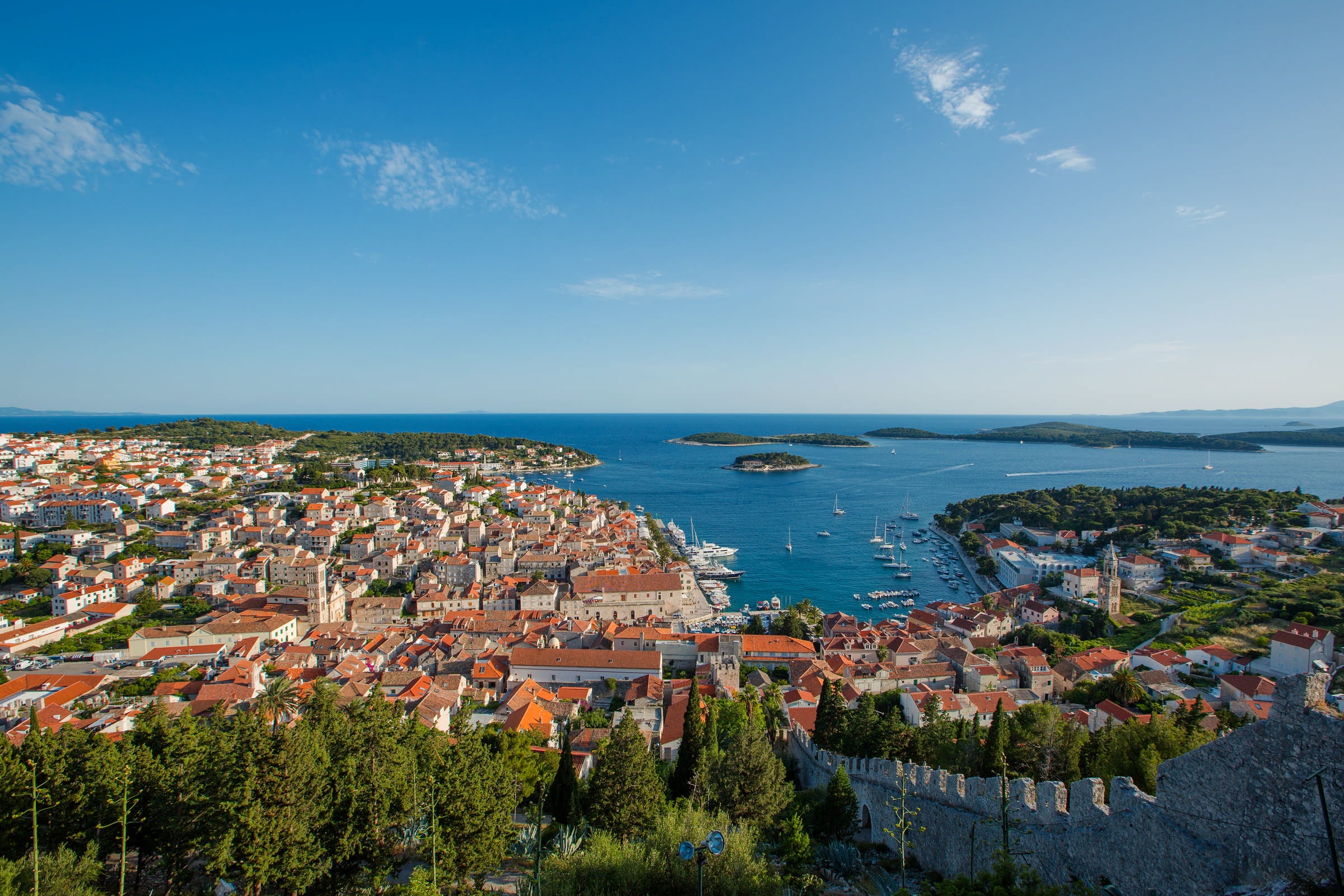 Hvar town by Mario Romulic
Hvar town by Mario Romulic
Hvar: shielded from bura wind by the island’s hills, and from sirocco wind by Pakleni islands, it enjoys a well-deserved reputation as a very favourable climate. Cypress, agave, carob and palm trees thrive there magnificently.
A particular thought stands out in this paragraph. At the time of his visit in the late 19th century, organised tourism was already in development in Croatia, notably in two destinations both mentioned here. Marcotti says:
If direct lines by sea between Italy and Dalmatia were properly established, Hvar town would be a highly recommendable winter destination for the Adriatic regions of the Kingdom, incomparably preferable to Opatija.
According to Spon, Hvar town was an inviting place even two hundred years earlier:
The people of the island, who are three or four thousand in number, have all withdrawn to the town of the same name so they can watch foreigners occasionally dock in their port. So they could receive them with more dignity, they have made there a beautiful pier of marble and stone blocks which lines the semi-circular port.
There is very good bread and very good wine, and plenty of sardines to whet the appetite, with which they also supply Italy and Greece.
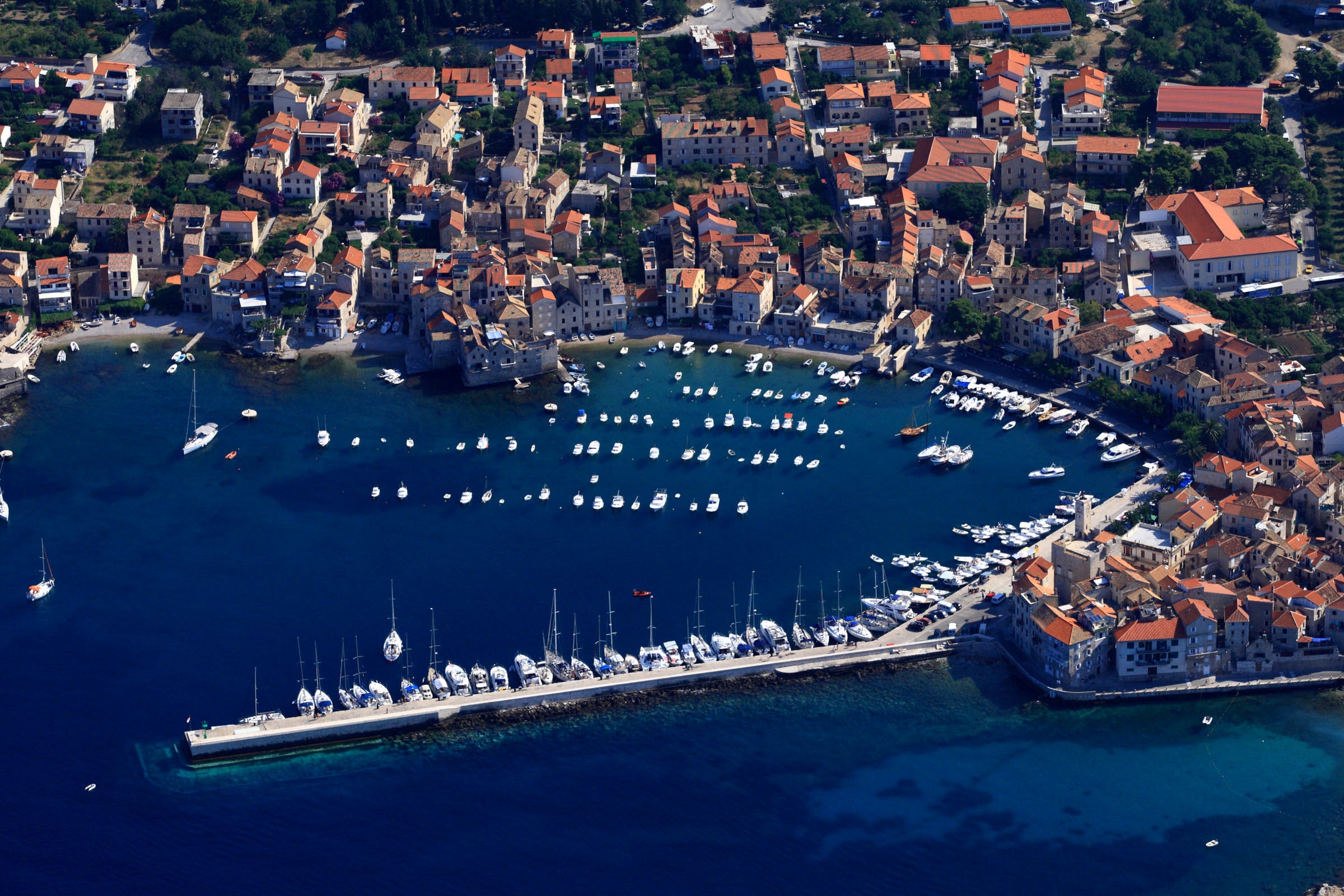 Komiža on Vis island by Mario Romulic
Komiža on Vis island by Mario Romulic
Vis: The island’s vegetation has a distinct southern character, with almond trees, figs, and palm trees. Some excellent wines are the opollo, the Margherita, the prosecco, the gripola, as well as vinegar and brandy. Sardines are abundant in Komiža; anchovies, mackerel, sea bream and snapper are found in all the waters around the island. The suckling lambs are delicious owing to the aromatic pastures of rosemary.
Spon also visited Vis island, but wasn't impressed with the sights:
I won't talk about the fortress, it's just a crow's nest that could be knocked down with ease from the nearby rocks. In the whole garrison there is but one simple soldier who performs the roles of Captain, Sargent and Porter, much like that of Plautus.
He goes to Korčula next, where he learns about jackals:
As this island is covered in woods, it is a haven for several wild beasts. Among them is a certain animal which I am told is built like a dog, but has the cry of a cat or a peacock. If one lights a fire at night near these woods, one can hear a great number of them shrieking and chanting their rabid song, such that those who have never heard them before mistake them for people yelling. It is also said that they dig up the dead to feed on them, and they are good for naught else, but to make some horrid furs out of them.
Next up: Dubrovnik, plus a few places we missed on our way south!
Sources for part II:
Jacob Spon, Voyage de l'Italie, de Dalmatie, de Grece, et du Levant, Fait és années 1675. & 1676., Tome I (Antoine Cellier le fils, Lyon, 1678)
Noé Bianchi, Viaggio da Venezia al S. sepolcro, et al monte Sinai (Remondini, Bassano, 1770)
Giuseppe Marcotti, L’Adriatico Orientale, da Venezia a Corfu (1899)
Alberto Fortis, Viaggio a Dalmazia, 1774 (Croatian edition: Put po Dalmaciji, Globus, Zagreb, 1984)
Comtesse de La Morinière de La Rochecantin, Croisière en Adriatique et en Méditerranée (1907)
Quotes translated from Croatian, Italian and French by the author of the article.
Miletić: After Being Symbol of Progressive Policy, IDS is Taking Different Direction
ZAGREB, 5 Feb 2022 - The former leader of the Istria Democratic Party (IDS) and current Istria County prefect, Boris Miletić, issued a statement after his resignation from the party on Saturday, saying that the IDS had for years been "a symbol of progressive and liberal policies, a symbol of resistance to primitivism."
"We have built a progressive community in a country that does not have much to boast about. Unfortunately, the IDS is now taking a different direction, and obviously I have been recognised by the new leadership as the biggest obstacle to this political turnaround," Miletić said.
He said that no one had raised any of the reasons he was now being disciplined for at the party's extraordinary meeting last September when his report was adopted with one abstention.
"When I took political responsibility for the election results and when we were supposed to discuss it, no one said a word, like many times before that," Miletić said, noting that while he had served as IDS president all decisions had been adopted by the party presidency and not in an autocratic manner as claimed by the new leadership.
He said that today he had tendered his resignation from the IDS after four victories in local elections, three terms in the national parliament, after winning seats in the European Parliament in two elections and after nearly eight years at the helm of the IDS which throughout that time was the strongest Croatian regional party.
Miletić said that with his resignation, after 29 years and for the first time since counties were established "the IDS has lost Istria County." "The new IDS president now has a chance to show freely what he knows and what he can do."
Meanwhile, Pula mayor Filip Zoričić demanded an early election in Istria County, calling on the IDS and Miletić "not to hold Istria as their hostage".
He said that as the mayor of the largest city in Istria he wanted the regional government to be stable and functioning regardless of which political group had a majority.
For more, check out our politics section.
Minister: Those Fishing in Troubled Waters During Euro Changeover to be Exposed
ZAGREB, 5 Feb 2022 - Economy and Sustainable Development Minister Tomislav Ćorić said on Saturday that anyone trying to fish in troubled waters by unjustifiably increasing prices during the euro changeover would be exposed.
"There will be continual monitoring by the state, and, I'm confident, by consumer associations as well. Those who fish in troubled waters and possibly increase prices without justification must be exposed," the minister told reporters during a visit to Split.
Speaking of inflation, he said that global markets had unfortunately started raising gas, electricity and oil prices and that the state could not influence it more significantly except by cutting taxes to alleviate the impact as much as possible after electricity and gas prices go up on 1 April.
"As of 1 April we will do our best so that the electricity and gas price increase is as small as possible," he said.
The minister also noted that this year's inflation would be slightly higher than last year's rate of 2.8%.
Ćorić said that he believed that if the situation on the energy market calmed down, Croatia would not experience the impact of price hikes as experienced by some other EU members.
Asked if inflation would have an impact on this year's tourist season, Ćorić said that if commodity prices increased by a few percentage points in the first half of the year, a likely rise in energy prices could lead to a rise in prices of services.
"I think it will have an effect (on this year's booking prices) but I hope that it will be reasonable and that we will not fish in troubled waters because that makes us less competitive," the minister said.
Asked if the government would cap fuel prices, Ćorić said the government would respond if the prices escalated.
Croatia Logs 11,230 New COVID-19 Cases, 43 Deaths
ZAGREB, 5 Feb 2022 - In the last 24 hours, there have been 11,230 new cases of infection with coronavirus in Croatia, while 43 patients have died, the national COVID-19 crisis management team said on Saturday.
A total of 7,536 new cases of the infection were identified with PCR tests while 3,694 were identified with rapid antigen tests.
The number of active cases now stands at 56,020, including 2,115 patients who are hospitalised, of whom 194 are on ventilators.
A total of 27,233 people are self-isolating.
Since the start of the epidemic in March 2020, 979,000 people have become infected with the novel coronavirus and 14,078 have died.
To date, 4,317,235 persons have been tested, including 15,314 in the past 24 hours.
A total of 56.62% of the total population has been vaccinated with at least one dose or 67.37% of adults. A total of 2,211,326 adults have been fully vaccinated.
JL: Public Should Know Who's Not Paying Rent for State-Owned Apartments
ZAGREB, 5 Feb 2022 - The Personal Data Protection Agency has stated that public interest is more important than the protection of personal details of politicians living in state-owned apartments, while state institutions withhold such information citing the GDPR, the Jutarnji List daily wrote on Saturday.
Gathering information for a story on the use of state-owned apartments by state officials, the newspaper has been denied information on the spending of taxpayers' money for this purpose, with the state authorities citing the GDPR or the EU General Data Protection Regulation.
The relevant government departments, Parliament and the Državne Nekretnine state property management company refused to reveal the names of office holders whose rent is paid from the budget and which ministers, state secretaries and members of Parliament are behind with utility bills and rent.
That's why Jutarnji List asked the Personal Data Protection Agency whether Državne Nekretnine is allowed to withhold such information.
"From the point of view of personal data protection, the right to personal data protection does not seem to prevail in this case and the information on the liabilities of state officials for the rental of state-owned apartments - the name of the official and the total amount owed - can be provided," the Agency said.
The Agency noted that the right to personal data protection is not an absolute right and should be balanced with other basic rights in accordance with the principle of proportionality, and one such right is the right of access to information, Jutarnji List said.
New IDS Leadership Launches Disciplinary Action Against Ex-leader
ZAGREB, 5 Feb 2022 - The presidency of the Istria Democratic Party (IDS) has launched disciplinary action against its former leader, Istria County Prefect Boris Miletić, for violating the party's code of ethics and statute.
In a statement from its meeting in Pula on Friday night, the new IDS leadership said that Miletić had taken some decisions "in an autocratic manner, without dialogue and without the knowledge and consent of the party's governing bodies."
The presidency discussed Miletić's responsibility for the result of the May 2021 local election, in which the IDS lost the confidence of a portion of its voters. It said that "no individual, no matter how deserving they may be, can come before the interests of Istrians and the IDS."
Miletić later said that he regretted s to see what was going on in his own party. "I am proud of everything that we have done in all these years and I will always be," he said and added: " I will never give in under pressure from individuals and different interests to the detriment of Istrians."
"The next move is mine," Miletić said..
Unofficially, 15 members of the IDS presidency voted in favour of disciplinary action and one abstained from the vote.


